Author: xidianwangtao@gmail.com
k8s-device-plugin内部实现原理图
在Kubernetes如何通过Device Plugins来使用NVIDIA GPU中,对NVIDIA/k8s-device-plugin的工作原理进行了深入分析,为了方便我们在这再次贴出其内部实现原理图:
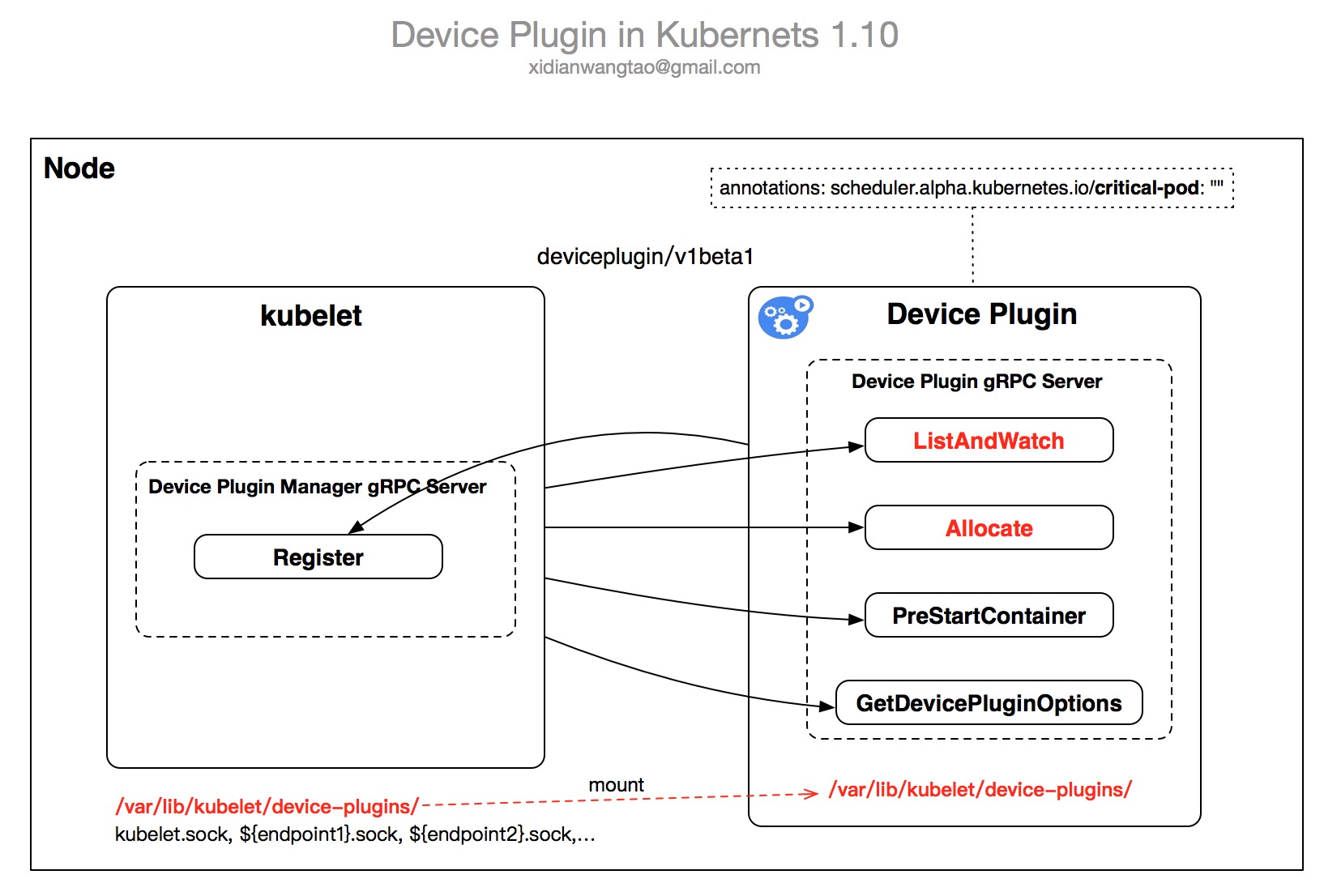
PreStartContainer和GetDevicePluginOptions两个接口,在NVIDIA/k8s-device-plugin中可以忽略,可以认为是空实现。我们主要关注ListAndWatch和Allocate的实现。
启动
一切从main函数开始!核心的代码如下:
func main() { log.Println("Loading NVML") if err := nvml.Init(); err != nil { select {} } ... log.Println("Fetching devices.") if len(getDevices()) == 0 { select {} } log.Println("Starting FS watcher.") watcher, err := newFSWatcher(pluginapi.DevicePluginPath) if err != nil { os.Exit(1) } ... log.Println("Starting OS watcher.") sigs := newOSWatcher(syscall.SIGHUP, syscall.SIGINT, syscall.SIGTERM, syscall.SIGQUIT) restart := true var devicePlugin *NvidiaDevicePlugin L: for { if restart { if devicePlugin != nil { devicePlugin.Stop() } devicePlugin = NewNvidiaDevicePlugin() if err := devicePlugin.Serve(); err != nil { ... } else { restart = false } } select { case event := <-watcher.Events: if event.Name == pluginapi.KubeletSocket && event.Op&fsnotify.Create == fsnotify.Create { restart = true } case err := <-watcher.Errors: case s := <-sigs: switch s { case syscall.SIGHUP: restart = true default: devicePlugin.Stop() break L } } } }
相关说明不需多说,请参考下面的流程逻辑图:
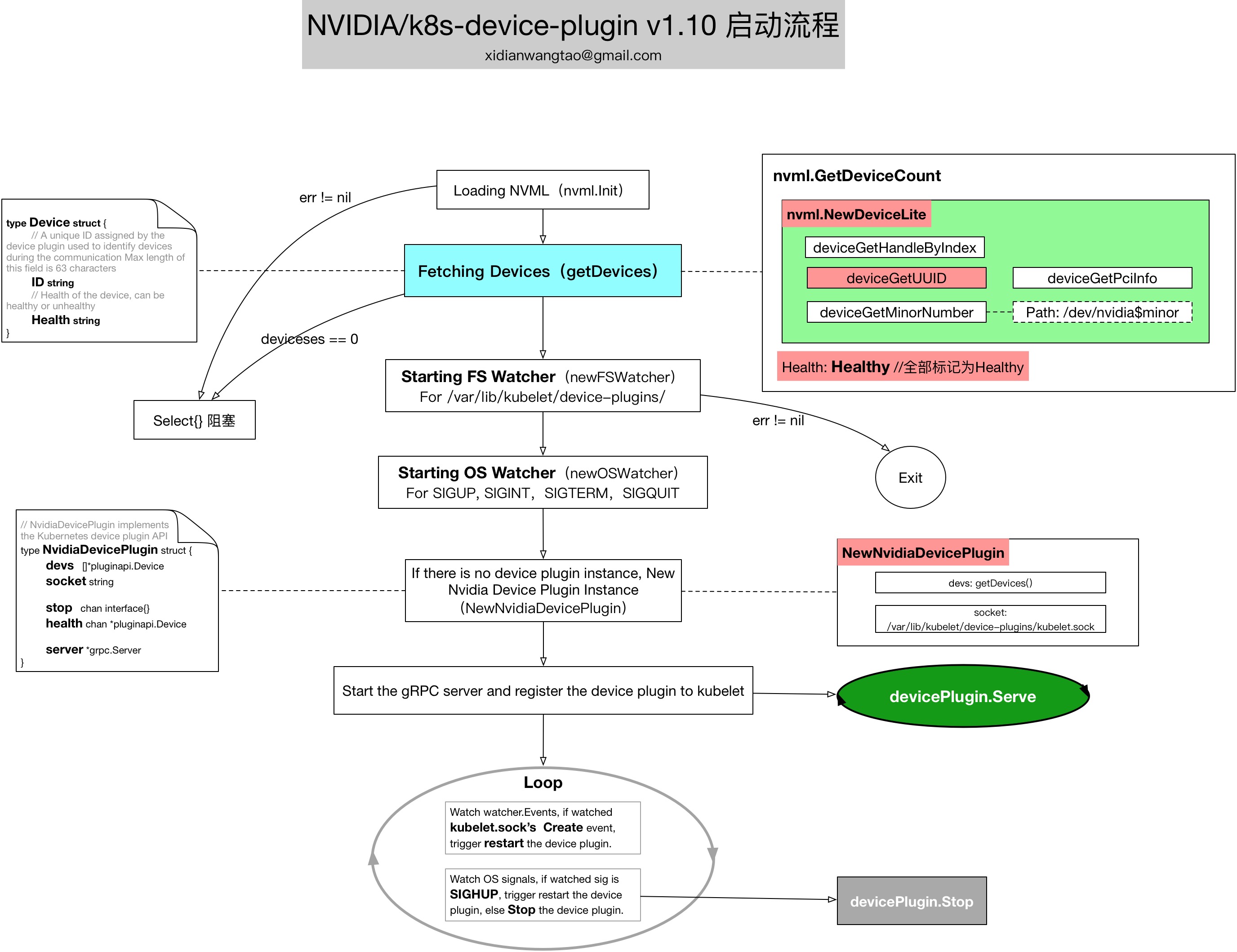
Serve
k8s-device-plugin启动流程中,devicePlugin.Serve负责启动gRPC Server Start对外提供服务,然后把自己注册到kubelet。
// Serve starts the gRPC server and register the device plugin to Kubelet func (m *NvidiaDevicePlugin) Serve() error { err := m.Start() if err != nil { log.Printf("Could not start device plugin: %s", err) return err } log.Println("Starting to serve on", m.socket) err = m.Register(pluginapi.KubeletSocket, resourceName) if err != nil { log.Printf("Could not register device plugin: %s", err) m.Stop() return err } log.Println("Registered device plugin with Kubelet") return nil }
Start
Start的代码如下:
// Start starts the gRPC server of the device plugin func (m *NvidiaDevicePlugin) Start() error { err := m.cleanup() if err != nil { return err } sock, err := net.Listen("unix", m.socket) if err != nil { return err } m.server = grpc.NewServer([]grpc.ServerOption{}...) pluginapi.RegisterDevicePluginServer(m.server, m) go m.server.Serve(sock) // Wait for server to start by launching a blocking connexion conn, err := dial(m.socket, 5*time.Second) if err != nil { return err } conn.Close() go m.healthcheck() return nil }
更加深入的代码调用关系,这里不多介绍,直接贴出Start的实现逻辑图:
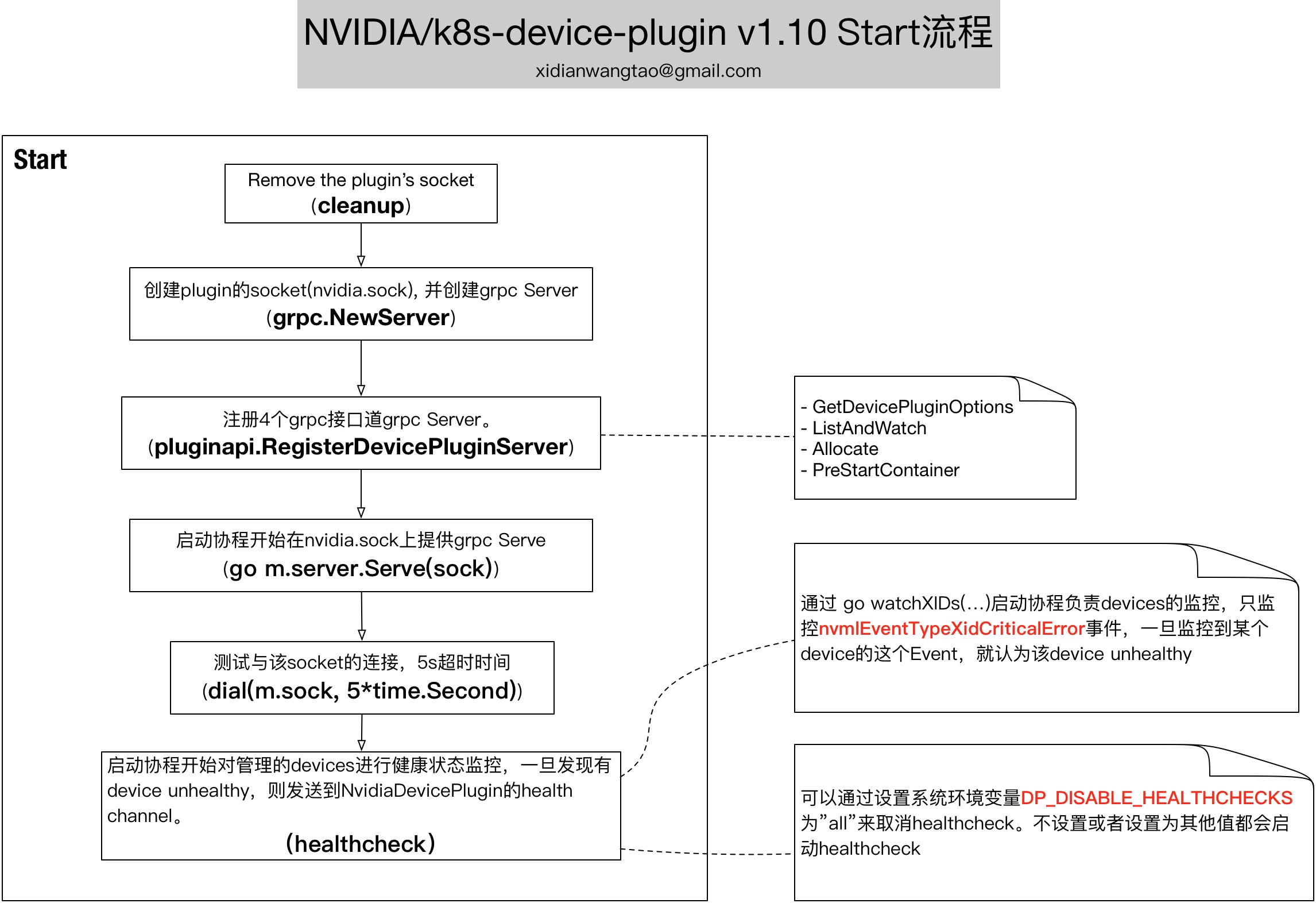
Start流程中负责创建nvidia.sock文件。
需要特别说明healthcheck部分:
- healthcheck启动协程对管理的devices进行健康状态监控,一旦发现有device unhealthy,则发送到NvidiaDevicePlugin的health channel。device plugin的ListAndWatch会从health channel中获取这些unhealthy devices,并通知到kubelet进行更新。
- 只监控
nvmlEventTypeXidCriticalError事件,一旦监控到某个device的这个Event,就认为该device unhealthy。关于nvmlEventTypeXidCriticalError的说明,请参考NVIDIA的nvml api文档。 - 可以通过设置NVIDIA device plugin Pod内的环境变量
DP_DISABLE_HEALTHCHECKS为”all”来取消healthcheck。不设置或者设置为其他值都会启动healthcheck,默认部署时不设置。
Register
Start之后,接着进入Register流程,其代码如下:
// Register registers the device plugin for the given resourceName with Kubelet. func (m *NvidiaDevicePlugin) Register(kubeletEndpoint, resourceName string) error { conn, err := dial(kubeletEndpoint, 5*time.Second) if err != nil { return err } defer conn.Close() client := pluginapi.NewRegistrationClient(conn) reqt := &pluginapi.RegisterRequest{ Version: pluginapi.Version, Endpoint: path.Base(m.socket), ResourceName: resourceName, } _, err = client.Register(context.Background(), reqt) if err != nil { return err } return nil }
Register的实现流程图如下:
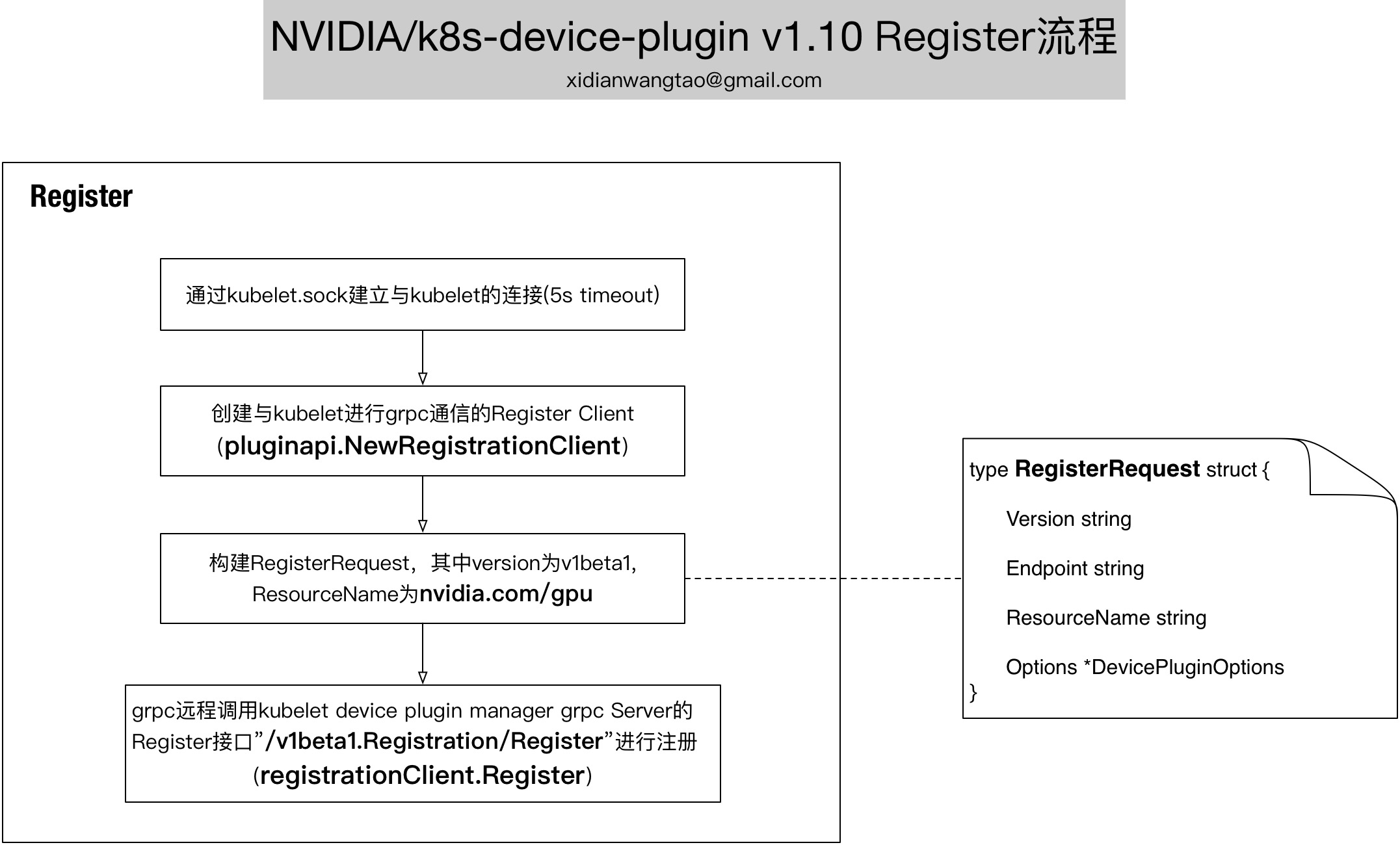
- 注册的Resource Name是
nvidia.com/gpu - 注册的Version是
v1beta1
Stop
Stop的代码如下:
// Stop stops the gRPC server func (m *NvidiaDevicePlugin) Stop() error { if m.server == nil { return nil } m.server.Stop() m.server = nil close(m.stop) return m.cleanup() }
Stop的实现流程图如下:
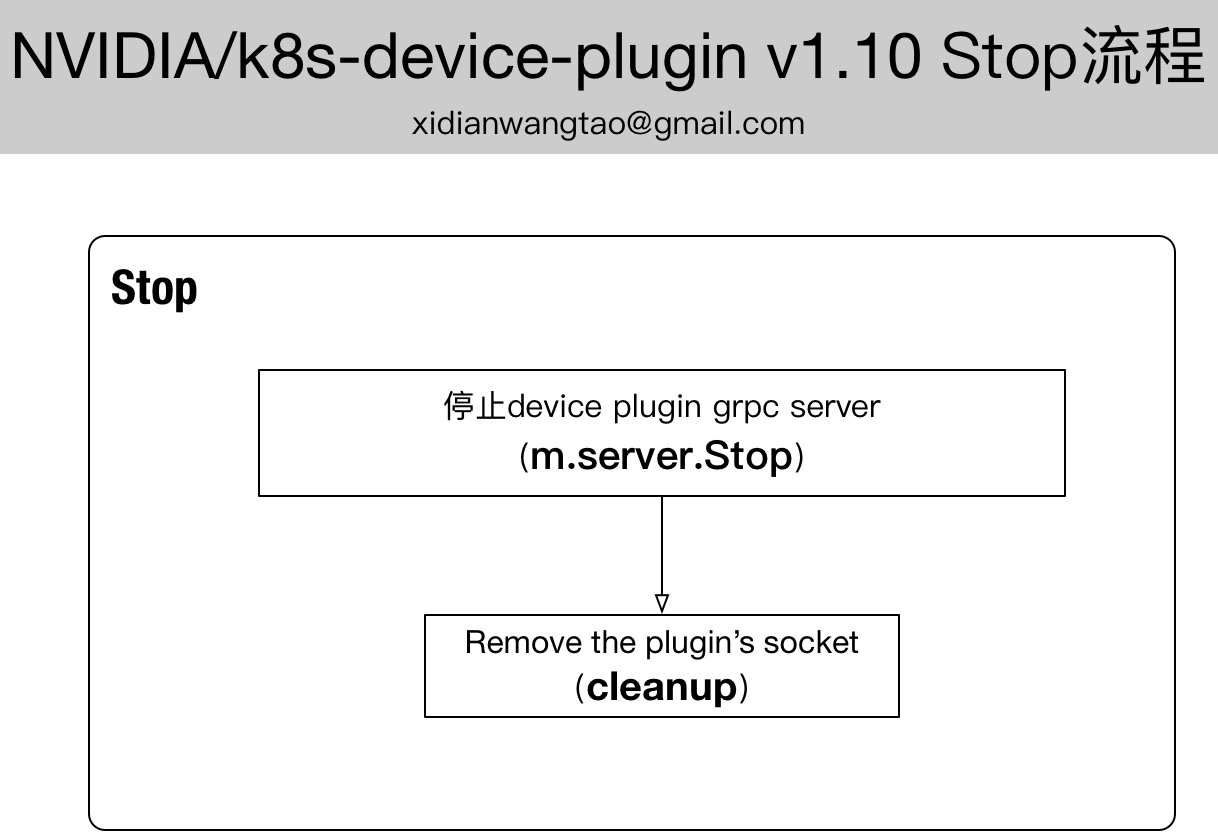
- Stop流程中负责停止gRPC Server,并删除nvidia.sock。
ListAndWatch
ListAndWatch接口主要负责监控health channel,发现有gpu变成unhealthy后,将完成的gpu list信息(ID和health状态)发送给kubelet进行更新。
// ListAndWatch lists devices and update that list according to the health status func (m *NvidiaDevicePlugin) ListAndWatch(e *pluginapi.Empty, s pluginapi.DevicePlugin_ListAndWatchServer) error { s.Send(&pluginapi.ListAndWatchResponse{Devices: m.devs}) for { select { case <-m.stop: return nil case d := <-m.health: // FIXME: there is no way to recover from the Unhealthy state. d.Health = pluginapi.Unhealthy s.Send(&pluginapi.ListAndWatchResponse{Devices: m.devs}) } } }
ListAndWatch的实现流程图如下:
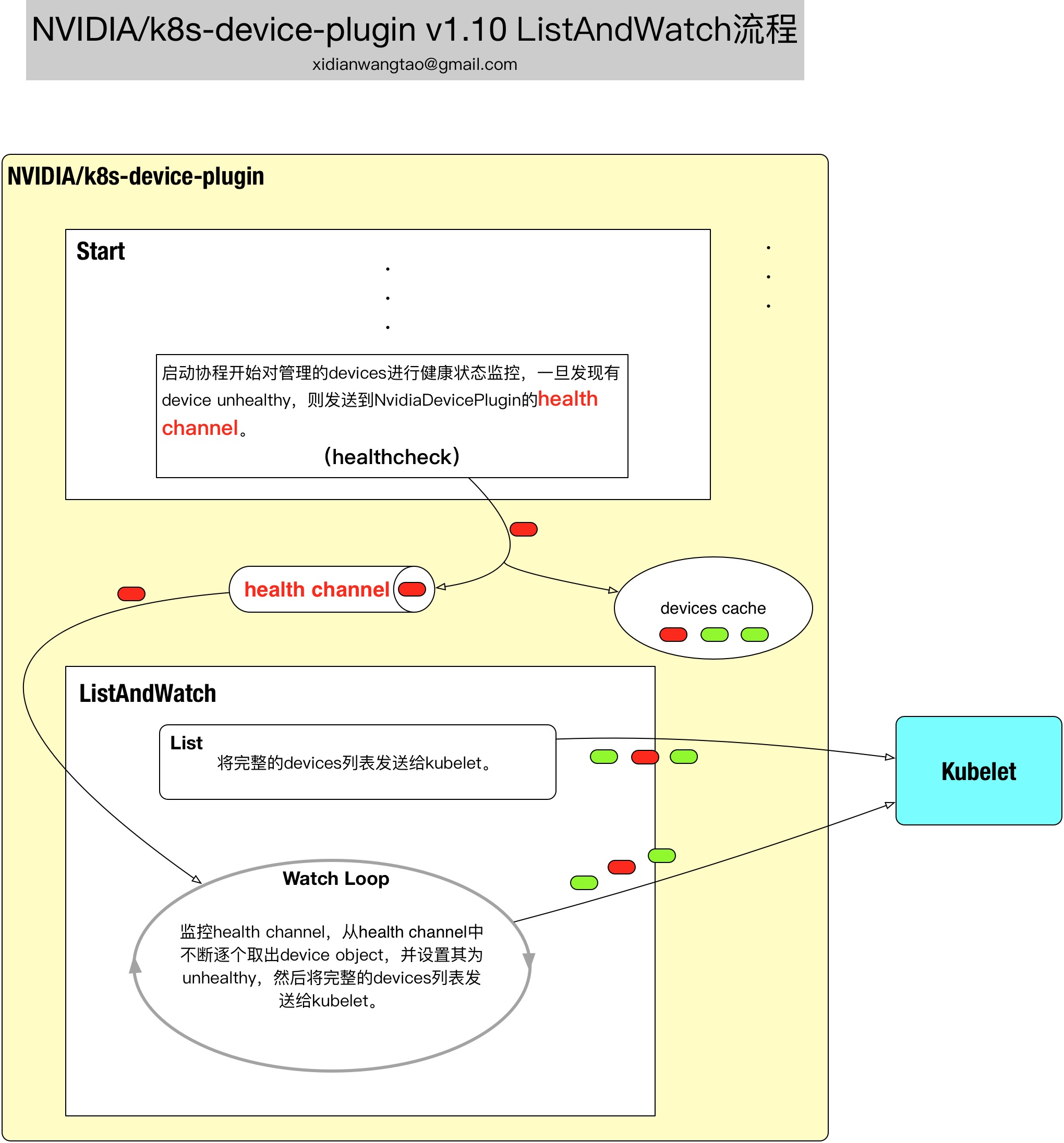
Allocate
Allocate负责接口kubelet为Container请求分配gpu的请求,请求的结构体如下:
// - Allocate is expected to be called during pod creation since allocation // failures for any container would result in pod startup failure. // - Allocate allows kubelet to exposes additional artifacts in a pod's // environment as directed by the plugin. // - Allocate allows Device Plugin to run device specific operations on // the Devices requested type AllocateRequest struct { ContainerRequests []*ContainerAllocateRequest `protobuf:"bytes,1,rep,name=container_requests,json=containerRequests" json:"container_requests,omitempty"` } type ContainerAllocateRequest struct { DevicesIDs []string `protobuf:"bytes,1,rep,name=devicesIDs" json:"devicesIDs,omitempty"` }
device plugin Allocate的Response结构体定义如下:
// AllocateResponse includes the artifacts that needs to be injected into // a container for accessing 'deviceIDs' that were mentioned as part of // 'AllocateRequest'. // Failure Handling: // if Kubelet sends an allocation request for dev1 and dev2. // Allocation on dev1 succeeds but allocation on dev2 fails. // The Device plugin should send a ListAndWatch update and fail the // Allocation request type AllocateResponse struct { ContainerResponses []*ContainerAllocateResponse `protobuf:"bytes,1,rep,name=container_responses,json=containerResponses" json:"container_responses,omitempty"` } type ContainerAllocateResponse struct { // List of environment variable to be set in the container to access one of more devices. Envs map[string]string `protobuf:"bytes,1,rep,name=envs" json:"envs,omitempty" protobuf_key:"bytes,1,opt,name=key,proto3" protobuf_val:"bytes,2,opt,name=value,proto3"` // Mounts for the container. Mounts []*Mount `protobuf:"bytes,2,rep,name=mounts" json:"mounts,omitempty"` // Devices for the container. Devices []*DeviceSpec `protobuf:"bytes,3,rep,name=devices" json:"devices,omitempty"` // Container annotations to pass to the container runtime Annotations map[string]string `protobuf:"bytes,4,rep,name=annotations" json:"annotations,omitempty" protobuf_key:"bytes,1,opt,name=key,proto3" protobuf_val:"bytes,2,opt,name=value,proto3"` }
Allocate的代码实现如下:
// Allocate which return list of devices. func (m *NvidiaDevicePlugin) Allocate(ctx context.Context, reqs *pluginapi.AllocateRequest) (*pluginapi.AllocateResponse, error) { devs := m.devs responses := pluginapi.AllocateResponse{} for _, req := range reqs.ContainerRequests { response := pluginapi.ContainerAllocateResponse{ Envs: map[string]string{ "NVIDIA_VISIBLE_DEVICES": strings.Join(req.DevicesIDs, ","), }, } for _, id := range req.DevicesIDs { if !deviceExists(devs, id) { return nil, fmt.Errorf("invalid allocation request: unknown device: %s", id) } } responses.ContainerResponses = append(responses.ContainerResponses, &response) } return &responses, nil }
下面是其实现逻辑图:
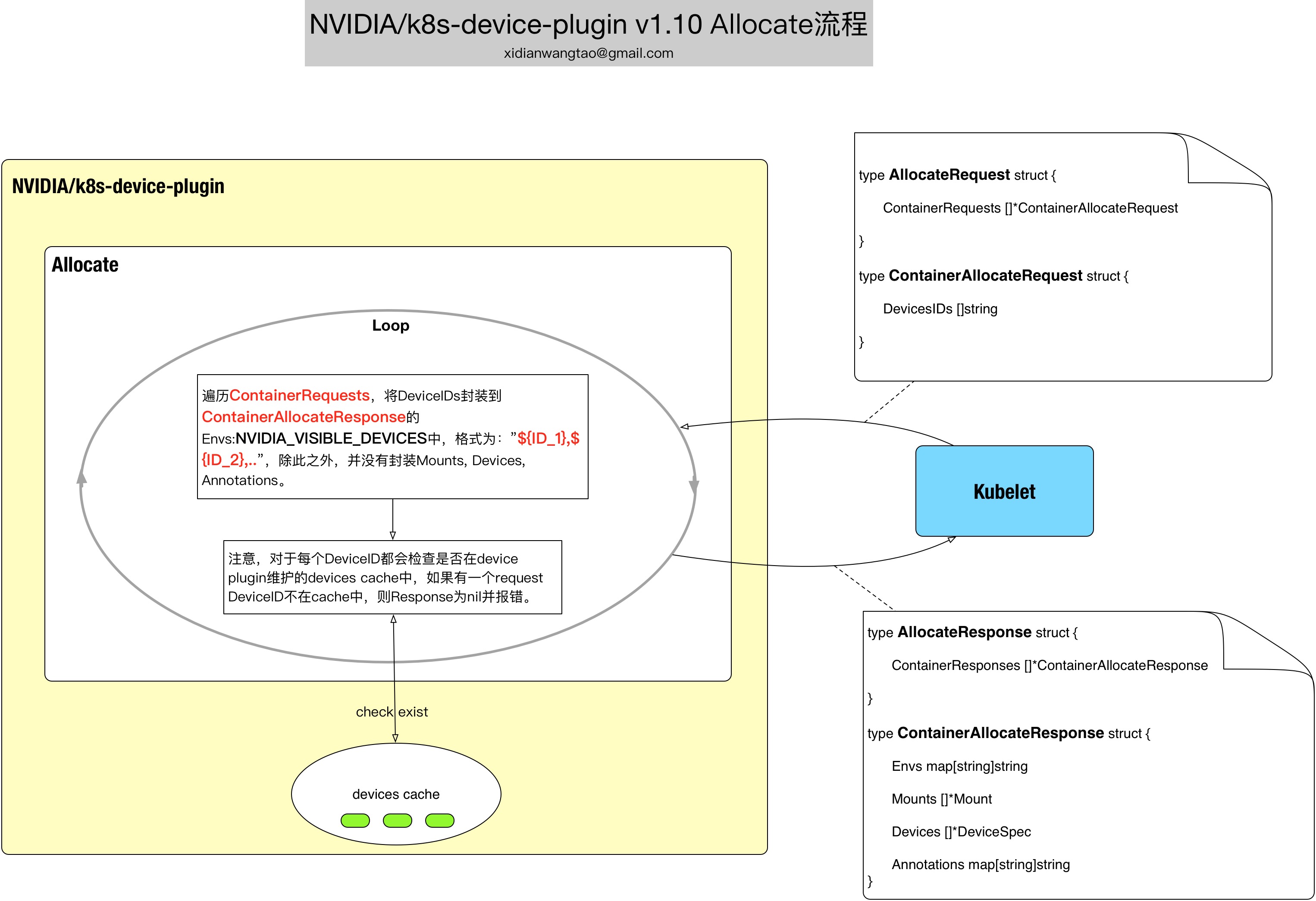
- Allocate中会遍历ContainerRequests,将DeviceIDs封装到ContainerAllocateResponse的
Envs:NVIDIA_VISIBLE_DEVICES中,格式为:”${ID_1},${ID_2},...” - 除此之外,并没有封装Mounts, Devices, Annotations。
总结
NVIDIA/k8s-device-plugin的代码中,依赖于nvidia-docker代码库,存在很多golang调用C库的地方,还需要大家自行到[nvml api文档](https://docs.nvidia.com/deploy/nvml-api)中查看相关C函数声明。上一篇博客介绍了Kubernetes如何通过Device Plugins来使用NVIDIA GPU,这篇博客介绍NVIDIA/k8s-device-plugin的代码实现流程,下一篇博客我觉得还有必要对kubelet device plugin manger进行代码分析,如此才能完整的理解整个交互细节。








